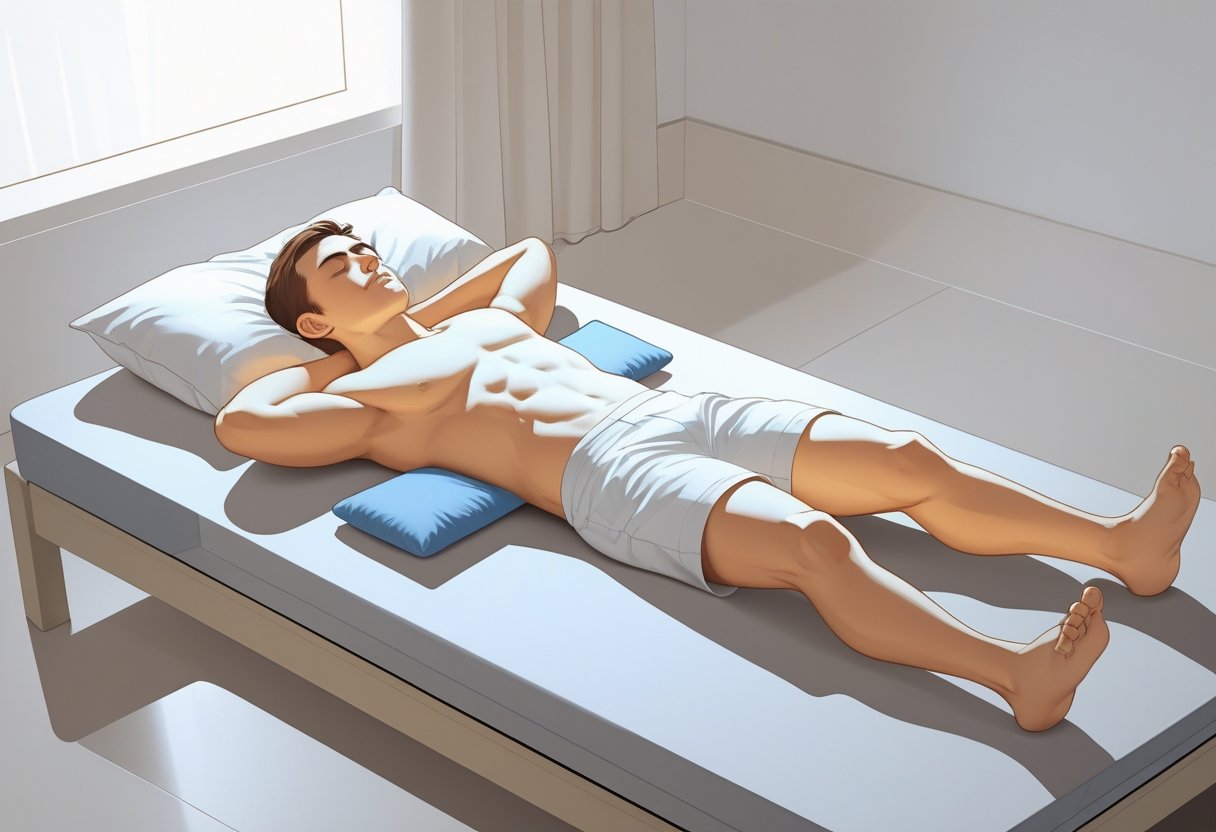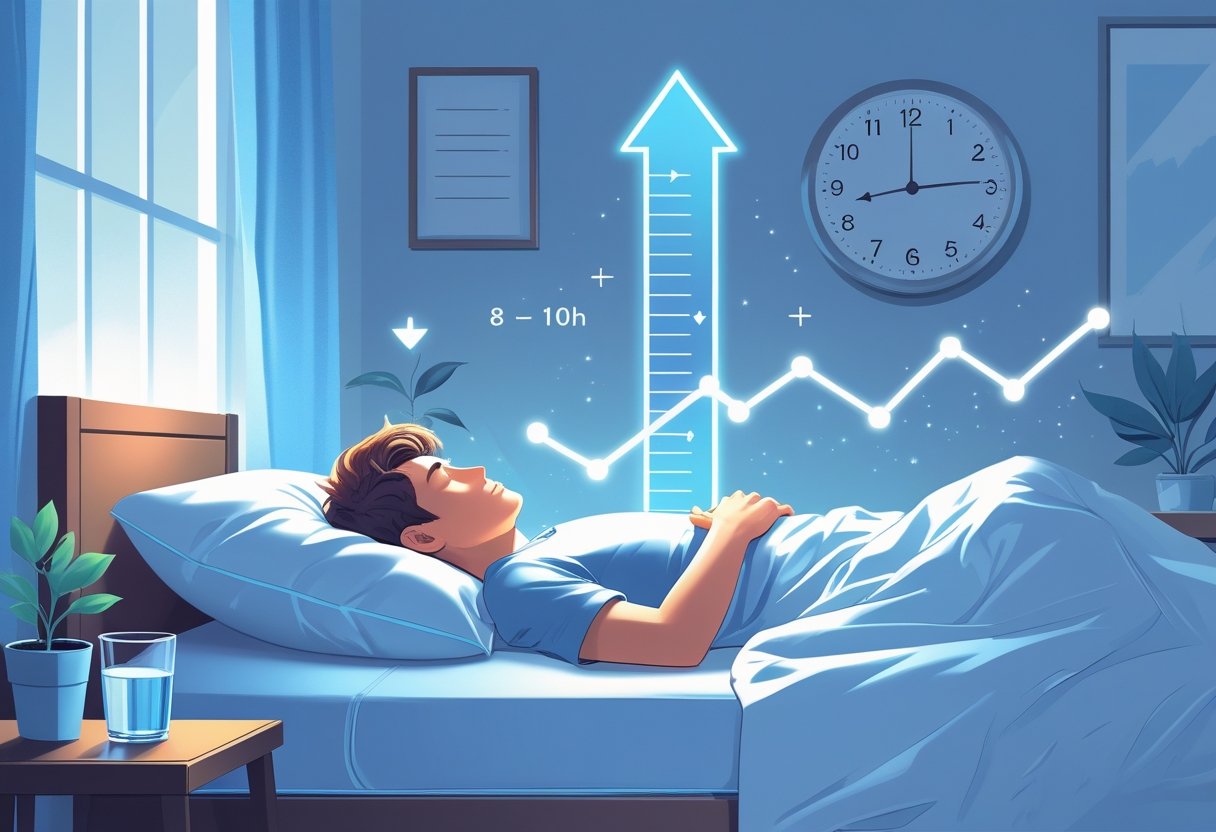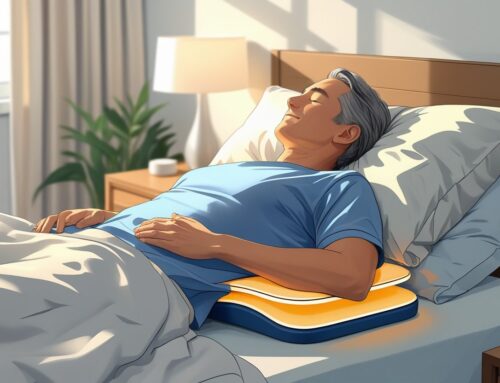Sleeping well is important in supporting height, especially during the growing years. While adults cannot increase their height by changing sleep habits, proper rest helps maintain good posture and can make a person appear taller. For those still growing, the best way to sleep for height is to lie in positions that support the spine and promote deep, uninterrupted rest.
Getting enough quality sleep each night remains vital because growth hormone, responsible for height increase, releases primarily during deep sleep. Going to bed early and aiming for 8 to 9 hours sets the ideal conditions for growth. Certain positions, such as lying flat on the back with arms at your side, help keep the spine aligned and reduce pressure that might compress the body during sleep.
A mattress that supports the body evenly also plays an important role in preventing curvature or discomfort. Combining good sleep habits, proper positioning, and a supportive mattress creates an environment where the body can grow and recover efficiently.
Key Takeaways
- Deep and quality sleep is essential for growth hormone release.
- Sleeping positions that support spinal alignment help maximize height potential.
- Adequate rest on a supportive mattress improves conditions for growth.
- A supportive mattress that encourages proper spinal alignment and allows for uninterrupted deep sleep provides the ideal environment for growth hormone release, a key factor in height increase and overall healthy development.

The Science Behind Sleep and Height Growth

Physical growth relies heavily on rest, especially during childhood and adolescence. The body repairs and rebuilds tissues, while important hormones that regulate growth release during sleep. The depth and quality of rest directly influence these processes.
How the Body Grows During Sleep
The body grows most efficiently during sleep because cells regenerate and tissues repair themselves. Muscle and bone growth happen as the body recovers from daily activities. Growth occurs not only by adding new cells but also through the elongation of bones, especially in youngsters.
Although some growth can take place during waking hours, sleep remains vital because it allows long and uninterrupted periods for repair and regeneration. Children and teens who lack enough sleep may experience slower growth. Adults generally do not grow taller since their growth plates close after adolescence.
Role of Growth Hormone Release at Night
Growth hormone (GH) acts as the main driver of height increase and is released mostly by the pituitary gland during sleep. Its highest secretion happens during deep sleep stages, particularly soon after falling asleep. This hormone stimulates cartilage cells in growth plates to multiply and enlarge, which helps bones lengthen.
When sleep is poor or too short, growth hormone release declines. This can slow growth in young people. That is why sleep problems affect not only height but also muscle and bone development. Adults, however, have limited potential for height growth even with good GH release.
Stages of Sleep Critical for Growth
Deep sleep, also called slow-wave sleep (SWS), stands as the stage most linked to growth. It usually occurs within the first few hours of sleep and triggers growth hormone surges. During this phase, the body focuses on repair and development.
Other sleep stages, such as REM sleep, support brain function and emotional health but influence height less. Consistently getting enough deep sleep remains essential for young people who want to maximize their growth potential.
- Deep Sleep (SWS): Highest growth hormone release
- REM Sleep: Supports brain and emotional development only
Sleeping well and long enough each night matters for those wondering, “Do you grow when you sleep?” or “Does sleep help you grow taller?” The better the quality of sleep, the more the body performs these vital growth functions.
Optimal Sleeping Positions to Maximize Height Potential
Proper sleeping positions help maintain spine health and posture, both of which influence how tall a person appears. Sleeping in ways that keep the spine aligned and relieve pressure on joints supports overall body structure. Restful, uninterrupted sleep boosts growth hormone production, a key factor for height during the growing years.
Is Sleeping Straight Beneficial?
Sleeping straight, or lying flat on the back, supports good posture by keeping the spine neutral. When the body lies straight, the spine faces less risk of curving unnaturally during rest. This helps preserve the spine’s natural length over time.
However, sleeping perfectly straight does not make someone physically taller. Height primarily depends on genetics and childhood growth. Still, this position helps avoid slouching and spine compression that could slightly reduce the appearance of height.
Using a supportive pillow and mattress keeps the body straight without strain. This posture lowers the chance of back pain and improves sleep quality, which is important in growth hormone release.
Impact of Sleeping on Your Back
Sleeping on the back often receives recommendations for spine health. This position distributes body weight evenly, reducing pressure on joints and discs. It encourages the spine to remain aligned throughout the night. Back sleeping helps prevent spine compression that may occur in curled or twisted positions. Reduced compression allows the spine to rest in its natural posture, aiding in retaining full height.
Although this position supports spinal health, it does not increase height after growth plates close. Still, it helps the body recover and maintain good posture, contributing to a taller appearance. Adjusting sleeping surfaces to support the back ensures comfort and effectiveness.
Sleeping Posture and Spinal Alignment
Spinal alignment proves vital for preserving height potential and preventing back issues. Proper sleeping posture maintains the three natural curves of the spine: neck, upper back, and lower back. Misalignment during rest can cause muscle tension and spinal problems.
To maintain spinal alignment, avoid curling up too tightly or sleeping twisted. A neutral spine allows discs to decompress and reduces strain on ligaments. Placing pillows under the knees or neck supports this alignment.
Preserving the spine’s natural curves during rest benefits overall posture and height appearance. Quality sleep positions enhance the body’s ability to regenerate tissue, indirectly supporting growth.

Best Sleep Duration for Height Increase
Getting the right amount of rest helps in growth and development. Adequate hours of sleep support the body’s natural processes that help a person reach their full height potential. Understanding how much rest is needed and how different amounts affect growth proves important.
Recommended Hours of Sleep for Growth
Most experts agree children and teens require between 8 to 11 hours of sleep per night for healthy growth. This range allows the body to produce growth hormone, which becomes essential during puberty and adolescence. Adequate sleep supports bone and muscle development.
Regularly sleeping less than 8 hours can reduce the amount of growth hormone released. Over time, this might slow the growth rate. Sleep quality also matters; deep and restful sleep improves growth hormone production more than light or interrupted sleep.
Following a consistent sleep schedule, especially before 10 pm, often maximizes growth potential. The years around puberty remain the most important to prioritize good sleep habits.
The Effect of Sleeping 8 vs 10 Hours
Sleeping 8 hours generally proves enough for growth in most children and teenagers. It falls within the recommended range and allows sufficient time for deep sleep stages. This amount supports normal growth hormone levels and body repair. Some wonder if sleeping 10 hours will increase height further. While 10 hours provides extra rest, it does not automatically make a person taller. Growth depends more on overall health, nutrition, and genetics than simply longer sleep.
Sleeping too long may not add benefits and could interfere with daily activities or reduce physical exercise, both important for growth. In short, sleeping 8 hours is enough for most, but extra rest can help during heavy growth phases.
Does Sleeping More Make You Taller?
Sleeping beyond the recommended 8 to 11 hours does not directly increase height beyond genetic limits. Height mostly depends on genetics, while sleep helps the body reach this natural maximum.
Getting enough sleep supports overall health and growth hormone release, but simply “sleeping more” does not guarantee more growth. Occasional longer sleep might help catch up on rest, yet consistent lack of sleep harms growth.
Increased sleep does not serve as a treatment to grow taller but rather supports healthy development. Focusing on a balanced diet, exercise, and sleep quality offers a better strategy than merely increasing hours spent in bed.

How Sleep Affects Height During Development
A key factor in growth involves the release of growth hormones, which depends greatly on the quality and amount of rest. These aspects influence height, especially during critical growth phases. Understanding these effects clarifies how rest fits into height development.
Children and Teenagers
During childhood and adolescence, the body depends heavily on deep rest to release growth hormone. This hormone remains necessary for bone and tissue growth. Without enough restful sleep, the body produces less growth hormone, which slows height increase.
Experts recommend that children and teenagers get between 8 to 10 hours of sleep each night. Consistent, deep rest supports bone development and allows the body to reach its full height potential. Research shows the relationship between rest and growth peaks in these years, when the body grows rapidly.
Other factors like nutrition and genetics also influence height, but rest ranks among the most controllable. Sleeping well helps maintain ideal conditions for natural height growth during these phases.
Adults and Height Maintenance
For adults, height remains mostly fixed once growth plates close after puberty. Rest no longer affects height increase but still plays an important role in overall bone health and posture. Poor rest can cause slouching or spinal compression, which may make a person appear shorter temporarily.
Good sleep habits allow the body to repair cartilage and maintain strong bones. Adults who get enough quality rest lower the chances of height loss caused by spinal issues or bone weakening. Rest cannot reverse height loss but supports maintaining current height by promoting proper body support.
Adults should aim for 7 to 9 hours of restful sleep to support bone health and posture. This can indirectly influence how tall they appear each day.

Practical Tips for Using Sleep to Support Growth
Good sleep supports growth by allowing the body to repair and develop. Small changes in the sleeping environment and routines can create a noticeable difference in how well the body uses sleep for growth.
Creating a Healthy Sleep Environment
The right environment helps the body maintain deep, uninterrupted sleep, which plays a vital role in growth hormone release. A quiet, dark room with a comfortable mattress and pillow reduces disturbances. Temperatures between 65 and 70 degrees Fahrenheit keep the body cool and promote restful sleep.
Limiting screen time before bed proves essential since blue light interferes with melatonin production. Using blackout curtains or a sleep mask blocks out light that could disrupt sleep cycles. Eliminating noise with earplugs or a white noise machine also enhances sleep quality.
Good posture during sleep supports spinal alignment. Sleeping on the back usually receives recommendation because it places less pressure on the spine than stomach or side positions.
Consistency in Sleep Routines
Setting regular sleep and wake times strengthens the body’s internal clock. Going to bed and waking up at consistent times each day helps regulate natural growth rhythms and hormone cycles. Avoiding late-night activities promotes faster sleep onset and longer rest. A bedtime routine that includes relaxing activities such as reading or stretching signals the body to prepare for sleep.
Getting between 8 and 10 hours of sleep matters for teens and young adults aiming to grow taller. Insufficient or irregular sleep limits the body’s ability to repair and build bone and muscle. Keeping caffeine and heavy meals away from bedtime prevents disruptions. Tracking sleep schedules reveals patterns that support or hinder proper rest.
Together, these habits improve sleep quality and naturally support the body’s growth processes through better rest.
How Your Mattress Affects Sleep Quality and Growth Potential
Quality rest significantly impacts growth potential by enabling the body to produce growth hormone, essential for increasing height. When discomfort interrupts rest, the time spent in deep sleep stages where growth hormone is released decreases.
Proper support maintains spinal alignment and prevents compression and strain that affect posture and comfort. Surfaces that are too soft or too firm often lead to poor sleeping positions, which may limit natural body growth overnight.
Consider these mattress features to support healthy growth:
- Firmness: Medium-firm options balance support and comfort.
- Pressure relief: Helps reduce body pain and promotes longer deep sleep.
- Durability: Prevents sagging that can harm spinal alignment.
- Material: Memory foam and latex contour to the body while supporting the spine.
Choosing a surface suited to one’s body weight and size encourages restful sleep. Restorative sleep supports hormone production necessary for growth.
For those seeking a mattress that combines comfort, support, and cooling features, the Bear Pro Hybrid mattress gives a balanced medium-firm feel. Its cooling gel memory foam and individually encased coils promote proper spinal alignment and airflow, which enhances sleep quality, an essential factor for growth since proper alignment supports healthy posture and reduces strain during sleep.
The Bear Pro Hybrid mattress also uses performance fabric infused with Celliant, which may help improve circulation and promote faster recovery. This feature benefits anyone aiming to optimize sleep health, especially those with active lifestyles or physical demands. Improved circulation and quality rest support the body’s natural processes, including growth hormone release during deep sleep.
Overall, the Bear Pro Hybrid mattress blends advanced materials and thoughtful design to meet various sleep needs. It adapts well to different body types and sleeping positions and helps maintain comfort and support throughout the night. Sleeping on a mattress that encourages proper alignment and restful sleep gives the best conditions for the body to grow taller and stay healthy.

Frequently Asked Questions
Sleep duration and quality both are important in supporting height growth. Certain sleep positions help maintain good posture but don’t directly increase height. During adolescence, growth depends largely on consistent and adequate sleep, especially before the growth plates close.







